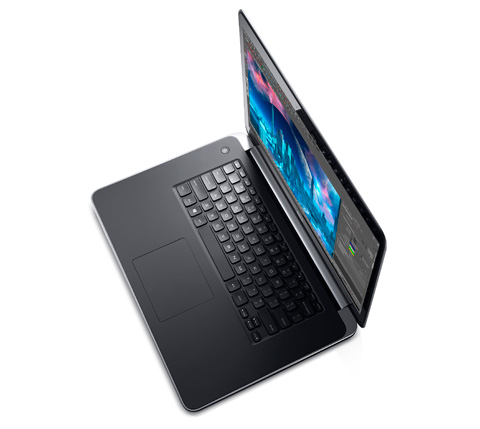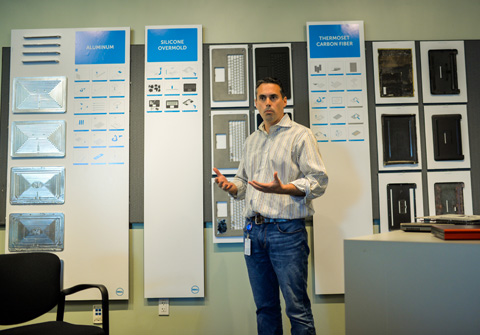
The Dell M3800 achieves its soft touch finish with a 0.5mm layer of silicone overmoulded on top of a lightweight magnesium frame
At DEVELOP3D, we’re big fans of the ultra slim mobile workstation, the Dell Precision M3800. It is a beautiful machine that combines power, portability and a 15.6-inch quad HD display – all in a chassis that weighs less than 2kg.
But one might not realise the amount of materials technology R&D that went into making this lightweight workstation-class laptop a reality.
The research was headed up by Dell’s global CMF team (colours, materials, finishes), which not only experiments with new materials and ideas, but drills down into the manufacturing process, creating prototype tooling, establishing supply chains and implementing everything into the new products.
Material choice
Few would argue that Apple revolutionised the laptop with its unibody MacBook chassis, which is machined from a single piece of aluminium.
Dell arguably drew inspiration from this premium product when designing the Precision M3800. But instead of using aluminium throughout, it applied different materials and manufacturing techniques to three key components: the display cover, the mid panel and the base.
The display panel
In addition to being light and thin, one of the key requirements of the display cover was to protect the quad HD panel. For this Dell developed a new manufacturing process which CNC machines forged aluminium, a material that exhibits greater strength than standard aluminium.
“To help us get the rigidity we wanted, and also some of the costs savings and benefits, we’d start by forging the metal, getting it to the basic shape, and then we’d come back and CNC that,” said Paul Doczy, Dell industrial design director. “The end result is an incredibly sturdy, solid part that is not only lightweight, but beautiful.”

CAD journalist, Ralph Grabowski, gets to grips with the M3800’s soft touch silicon overmoulded mid panel
The mid panel
For the panel that surrounds the keyboard and trackpad Dell used magnesium, which is also exceptionally strong and lightweight. But, as is common with workstation-class laptops, the Precision M3800 creates a fair amount of heat, so Dell needed to find a way to ensure the palm rest surface didn’t get too hot.
“Doing experiments in house we found that silicone had great properties but the issue was how do you get silicone overmoulded onto the magnesium and maintain a very thin design,” said Doczy.
“So through this process of silicone overmould we take the magnesium – in its raw state, it’s not very pretty – and then we chop up silicone, we heat that in a press and we get it down to 1/2mm thick.
“That 1/2mm creates a protective bond with the magnesium that is not only very comfortable and easy to use, but keeps it cool to the touch.”
Dell’s unique silicone overmoulding process doesn’t end there. To keep fingerprints to a minimum, a special overcoat is sprayed on top of the silicone. “You’ve seen black soft touch products before that, after a while they start to get a little nasty looking,” explains Doczy. “If you play with the silicone on this [Dell Precision M3800] you’ll notice it really resists fingerprints quite well.”

Paul Doczy, Dell industrial design director, shows off the three advanced materials and manufacturing techniques used in the Dell Precsion M3800
The base
The base of the laptop threw up similar challenges in terms of how to keep the design lightweight and strong while shielding the user’s lap from heat.
Dell achieved this by using carbon fibre, which, in addition to being incredibly strong, is also a natural insulator.
“The engineers are able to maintain the highest level of performance in this box and not worry about skin temps [on the lap], because the material itself helps spread that load,” explains Doczy
The bottom of the laptop is finished off with a clear soft touch material, so the carbon fibre weave is clearly visible, making it a focus of the design. It’s an aesthetic that splits opinion, but certainly a bold expression of the advanced materials that go into making the M3800 so light and strong.
“[With the Precision M3800] we’re not just looking for decorative finishes, we’re looking for beautiful materials that bring us functional advantage,” concludes Ken Musgrave, Director of Design, Dell. “And we can tell any one of our customers exactly why we have picked each material and used it that way.”






